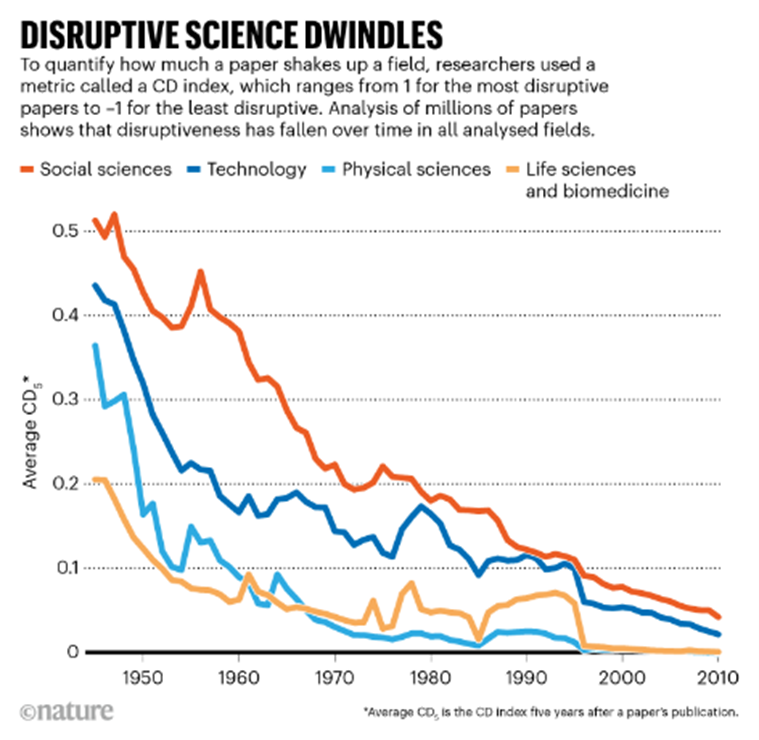
Disruptive science and innovation have been the driving forces behind human progress for centuries. From the invention of the wheel to the development of artificial intelligence, scientific breakthroughs have changed the way we live, work, and communicate. Interestingly though, while the volume of scientific literature has continued to increase exponentially over the past 50 years, concerns have been voiced on the decline in innovative activity and disruptive science. For instance, research papers, patents and even grant applications are becoming gradually less innovative when compared to previous years. This trend is being attributed to a variety of factors, including increased competition among researchers, changes in the funding landscape, and a shift in the way that scientific information is disseminated.
Citations indicative of incremental instead of disruptive science
According to a recent study by researchers at the University of Minnesota, which was published in Nature, this slowing rate of disruption in science may be indicative of a fundamental shift in the very nature of how we perceive science and technology today.1 The research team’s theory was based on an analysis of data drawn from 45 million papers published across six decades from 1945 to 2010 and 3.9 million patents from 1976 to 2010. The researchers used a previously tested metric called the CD index to measure disruption levels. The CD index is based on the idea that if a paper or patent is disruptive, the subsequent work that cites it will be less likely to also cite its predecessors. The study showed a decline in disruptive science across research fields and patent types with the average CD index for research manuscripts down more than 90% between 1945 and 2010 and over 78% from 1980 to 2010 for patents.2

Possible reasons for the downward trend
These downward trends have grabbed the attention of key stakeholders and policymakers as they can define the pace of innovation and growth across various fields. One of the main reasons stated for this decline in disruptive science is the increased competition among researchers. With more researchers competing for funding and recognition, there is a greater pressure to publish quickly and in as many journals as possible. This has led to a proliferation of lower quality journals, which are more likely to accept weaker incremental research and publish it faster. Increased competition and pressure also mean researchers are required to know and do more to stay ahead. Given time constraints and the pressure to publish, many researchers feel compelled to pursue topics that are more likely to yield publishable results, rather than investing time in ground-breaking research. There has also been a tendency to work as part of large research teams, which have been found to focus on more incremental knowledge rather than disruptive science.
Another factor that has contributed to the decline in disruptive science and innovation is the increasing commercialization of research. Many companies are now funding scientific research in order to develop new products and technologies that can be milked for profit. While this can lead to valuable advancements, it is also leading to an unfortunate focus on short-term goals that prioritize immediate financial gains over long-term scientific progress.
Furthermore, changes in the funding landscape over the past few years have affected researcher productivity. Researchers who depended heavily on grants and other forms of funding to support their work find themselves without the resources needed for their work as government funding for research and development has declined in many countries. In this scenario, researchers are choosing to focus on producing a high volume of articles, instead of conducting high-quality research that may take longer to produce. Consequently, this has led to a reduction in the number of cutting-edge projects being developed worldwide.
In addition to these broader systemic issues, there are also concerns about the decline of disruptive science and innovation in specific fields. For example, there has been a decline in the number of new antibiotics being developed, even as the threat of antibiotic-resistant bacteria continues to grow. This kind of decline is particularly concerning because they have the potential to impact human health and well-being. New treatments and technologies are needed to address the complex and pressing issues of our time, and without a strong focus on science and innovation, progress in these areas will stall.
Disruptive science – what the future looks like
The spurt in revolutionary research seen half a century ago has been on a steady decline, but this rate of decline seems to be levelling out in recent years.2 While the reduction in disruptive science is not necessarily a bad thing, as incremental science is still valuable, it is important to understand why this trend is occurring to continue advancing knowledge and shaping the future. The ideal scenario would be a balanced blend of disruptive science and incremental research which continually moves the world forward.2
Finally, there is hope that the decline in disruptive science and innovation can be reversed. By focusing on the quality rather than the quantity of scientific research, and by providing researchers with the resources they need to pursue their work, it is possible to revitalize the field and drive new breakthroughs. Additionally, by encouraging collaboration between scientists, innovators, and industry, we can ensure the benefits of scientific research, both incremental and transformative, are shared more broadly and used to create new products and technologies that can improve our lives.
References:
- Park, M., Leahey, E. & Funk, R.J. Papers and patents are becoming less disruptive over time. Nature, January 2023. Available on https://www.nature.com/articles/s41586-022-05543-x
- Kozlov, M. ‘Disruptive’ science has declined — and no one knows why. Nature News, January 2023. Available on https://www.nature.com/articles/d41586-022-04577-5


